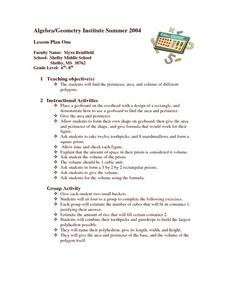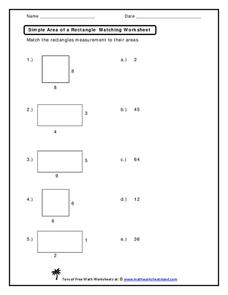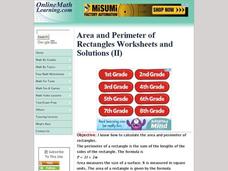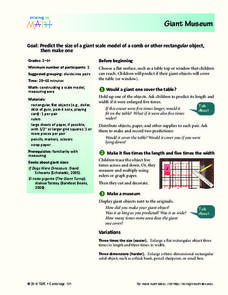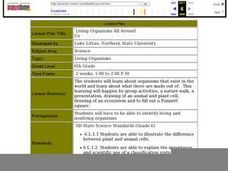Curated OER
Lesson One: Perimeter, Area, Volume
Students explore perimeter, area and volume. Using geoboards, toothpicks, and marshmallows, students create specific shapes. They are directed to use formulas to find the volume, area, and perimeter of the created shapes. In groups,...
Curated OER
Area of Polygons
In this geometry activity, 10th graders determine the area of regular polygons. The two page activity contains eight problems. Answers provided.
Curated OER
Identifying and Using Parallelism and Balance in Literature
Analyze the use of balanced sentences and parallelism in a narrative. Included in this resource is a narrative about serving as a Peace Corps volunteer in Kazakhstan titled, "The Train Ride Home". Middle and high schoolers review...
Curated OER
Area of Rectangles
In this area worksheet, students find the area of rectangles that are represented by square units. Students complete 6 problems on 10 pages.
Curated OER
Area of Rectangles in Word Problems
Although there are grammatical errors in these word problems, they provide a good opportunity for scholars to practice calculating area. Each of the 10 scenarios gives measurements of a specific rectangular space, including units....
Illustrative Mathematics
Floor Plan
A multi-step problem has learners finding the actual area based on a scale drawing and then converting units at the end. Two different solution choices are listed depending on the preference on which step to start first. Both methods can...
Curated OER
Simple Area of a Rectangle
What is the area? Although there are no units involved, beginning geometers will get some good practice as they calculate the area for three rectangles and two squares. They match the answers to a list, however you can easily increase...
Curated OER
Area and Perimeter of Rectangles Worksheet (II)
In this geometry worksheet, 10th graders determine area and perimeter of rectangles, given the width and the length. The one page interactive worksheet contains ten questions. Answers and hints are included.
Curated OER
Rectangular Gardens Within A Given Perimeter
Sixth graders design rectangular gardens with a given perimeter and generalize how to maximize the area Students applying the formulas for perimeter and area of polygons. They analyze length, area, and volume and make relationships...
CPM
Cones and Spheres
Geometry whizzes solve and complete 24 different problems that include determining the volume and surface area of spheres and cones. First, they use the given information to determine the volume of a cone. Then, pupils use the given...
National Park Service
Fitting In
Birds help other birds find food? Scholars are placed into one of five groups of different birds. Each group then "feeds" on letters of paper in a field and gather five pieces per person. As each group plays, more food is exposed,...
Curated OER
Giant Museum
Scholars make a giant scale model of an object. They will take a regular item and enlarge it to five times its length and width. They attempt this same concepts with a 3D model.
Curated OER
Play Area
In this finding the area of the letters P, L, A, and Y worksheet, students use visualization and knowledge of counting whole-squares and half-squares to solve the problems. Students find the areas of 4 letters.
Curated OER
Square Circles
Students analyze and demonstrate how a circle can be measured in square units and examine how diameter, circumference and radius are related.
California Education Partners
Tile Mural
Paste this resource into your lesson plans like you'd paste a tile onto a mural. Given a diagram of a tile mural with rectilinear figures, future artists determine the perimeters and areas of the figures. They must then develop their own...
Curated OER
Investigation Designing a Patchwork Quilt
Fourth graders practice calculating area by creating a classroom quilt. Students are given a 6x6 inch square material they design based on a classroom theme. A sample of the class quilt is created using graph paper so students may...
Indian Institute of Technology
Could King Kong Exist?
The title says it all: Could King Kong exist? Investigate how increasing the dimensions of an object affects its surface area and volume to mathematically conclude whether a creature with the weight and height of King Kong could actually...
Utah Education Network (UEN)
The Pasture and the Fence
Beginning geometers use tiles and grid paper to draw and calculate perimeter and area. Rectangles of different sizes are created and then measured to build understanding. The one-inch grid sheet referenced is attached.
Curated OER
Babylonian Mathematics I
Learners examine a Babylonian clay tablet and the mathematics found on it as a catalyst to investigate a variety of mathematical ideas. They work with prime numbers, classify numbers as whole, integer, rational, or irrational and use...
Balanced Assessment
Blirts and Gorks
Start a trend by using blirts and gorks as your standard unit of measures. The activity asks learners to take a known measures of blirts and gorks and develop a conversion ratio. Individuals use both perimeter and area measures of...
Balanced Assessment
Gligs and Crocs
Explore relationships between perimeter and area. Learners compare the measurement units of gligs and crocs. They use a given perimeter and area as well as specific measurement relationships to determine the scale of gligs to crocs.
Curated OER
Living Organisms All Around Us
Sixth graders study organisms that exist in the world and what they are made up of. They participate in a nature walk, a presentation, a drawing of an animal and plant cell, draw a ecosystem, and fill out a Punnett square.
University of Wisconsin
Sizing a Rain Garden
Most appropriate if you are applying the entire unit to build a rain garden at your school, this installment involves calculating the area that will drain into it. Your garden planners will need data from previous lessons, so this one...
Curated OER
Picking Patterns
In this pattern worksheet, students enumerate the number of objects that comes next in the sequence including triangles, blocks, and circles. There are 6 questions.


